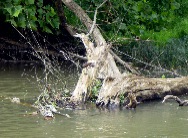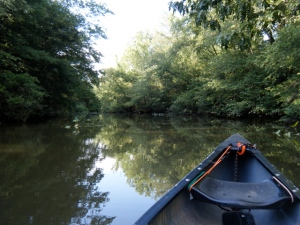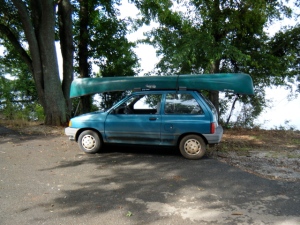
The Big Foot Hoaxers at the nationally televised press conference
It’s a little embarassing to admit this in public places, but since the big flap over Big Foot last August, I’ve been somewhat interested in the idea of cryptozoology. For those of you who missed the flap, a couple of goobers from Georgia got swirled up in hoaxing the finding of a big foot body. Their press conference announcing the find ran on most of the cable news networks and was quickly proven to be a hoax.
I’ve always been facinated by mystery animals, and in 2001 when I took a trip to Europe with friends I insisted, to the point of giving up the “right” to pick any other destination or activity, that we go to Inverness just so I could take a ride on Loch Ness and look for Nessie. I got that trip, and spending time in Inverness is still one of my favorite memories, right up there with my wedding, the arrival of my son and the birth of my daughter.
Scotland's famous Loch Ness
Other than that fruitless cruise on Loch Ness, I’ve never done any “searching” for any type of weird animal. In 1994 I did do a search for, and eventual found, a nesting pair of Bald Eagles near Winchester Tennessee. That was more an accident than a mission, I saw a bald eagle land on a telephone on my way to work at the newspaper in that small community. I was told I must be mistaken, since there were no bald eagles in that area. I saw it again the next day, and managed a fuzzy picture of it. Next thing I knew biologists from the University of Tennessee wanted to know more and they found the nest.
Since then, my interest in animals has been as an observer. I’m not the field research type of guy, prefering to watch animals from the comfort of my sofa. But if you’ve read my blog, you know I like to paddle about in a canoe so I’ve recently been up close to wildlife more than ever before in my life.

A snake sunning on a log I found on one of my trips.
I’ve seen some weird things, such as muskrats diving in deep pools and blue herons skimming the water in front of my boat. I’ve tipped over in snake infested waters and have been scared out of my wits by large fish jumping next to the canoe. I’ve developed a healthy respect for wildlife and the world we share with it.
In the 4 years I’ve been paddling, I’ve never gone looking for anything. Well, occasionally a snake or two, but I’ve been focused entirely on the trip and not the sights. But something has been brewing in the back of my mind and I finally acted on it.
There have been rumors of alligators living successfully in North Alabama for a while. Most biologists will tell you that it isn’t possible for Alligators to survive our occassionally harsh winters and lack of suitable habitat. Yet sightings continue, including a recently captured gator in DeKalb County this year and a gator found in a pond in Morgan County last year.
Ultimately it was a post to Loren Coleman’s blog, Cryptomundo, that prompted me to action. Coleman is one of the premier cryptozoologists, and he writes on all things weird and wonderful. He posted about out of place gators found around North America, and it included the following:
On Friday, June 5, 2009, The DeKalb County Animal Adoption Center in Alabama got quite a surprise when someone dropped off an alligator (above). Director Leslie Johnson told the local paper it’s the first exotic animal the center has received.
“A man brought it in the back of his truck,” Johnson said. “He said he found it on U.S. 11, and that’s all we know.”
Johnson said she is unsure where the 2-foot gator came from. Little River Superintendent John Bundy said it is unlikely the gator is from the area. State Lake Supervisor Jack Turner said there are gators native to central and South Alabama but not North Alabama.
“It’s a bit too far north and a bit too high in altitude for alligators in North Alabama,” Turner said. Turner said the reports of alligators in North Alabama are sporadic and there is no reason for him to believe there is a population of the reptiles in the area. Lt. Michael Casalini with the Alabama Department of Conservation and Natural Resources said if alligators were breeding in DeKalb County, there would be more sightings.
–Loren Coleman, Cryptomundo
Is State Lake Supervisor Jack Turner correct? Perhaps, but there are plenty of sightings in Madison and Morgan county indicating that there may be a breeding population there. And there is at least one KNOWN alligator living wild in North Alabama in Madison County.
“Stumpy” lives on Redstone Arsenal, the area’s primary employer. Stumpy crawls out onto one of the test ranges at the army base and gets his picture taken now and again. He’s a big fellow, and missing part of his tail, hence the name. If you work on post, you’ll see his picture in the Redstone Rocket now and again.
So if Stumpy is real, why can’t these other sightings be real? Where would a breeding population of Alligators live in North Alabama?
If the rumors are true, the perfect place exists between Huntsville and Decatur, in the Wheeler Federal Wildlife Refuge. If you visit there page, you won’t find alligators listed among the regular inhabitants, but buried on the FAQ’s page is this little tidbit:
Although seldom seen, American alligators do inhabit the Refuge. In the 1970’s, the alligator population had been reduced drastically, so 50 alligators were released here in an effort to help restore the species which at that time was federally listed as threatened. An estimated 40-50 alligators currently inhabit Wheeler NWR and at least one active nest was located during the summer of 2001.
—Wheeler Federal Wildlife Refuge website

My First Trip Gator Hunting in Wheeler National Wildlife Refuge
An active nest in 2001? Now since 1980, we’ve had several harsh winters. And yet the population has stayed stable? I’m not sure I buy this. In fact, I believe, with nothing to back me up, that the population is larger than this and that they are breeding successfully. Our summers are warm enough, our winters are typically mild enough and the American Alligator can survive up to two years without food, and can go dormant for long periods of time without moving, a sort of hibernation.

If you see this rig running around North Alabama, it isn't a clown car. That's me looking for gators!
Now I’m not suggesting that the refuge is teeming with alligators, but I do think the population is growing and spreading. And besides, no one around here believes the alligator stories. Everyone looks at me like I’m nuts when I mention the possibility of seeing a alligator from my canoe in North Alabama.
Well this is my birth month, and the presents came a little early. I got a new paddle and a waterproof digital camera. I’ve got a GPS system, thanks to my nifty iPhone, and it all seems to have come together. I could go look for these gators on my own, take a picture, record the GPS data and possibly find a nest. Or two. Or three. Prove that the Gators are growing.
So this past Sunday I started the project. I went out to Arrowhead Landing, put my canoe in the water, grabbed my new paddle, and headed out in search of alligator. But I made a lot of mistakes, most of them before I ever put the canoe in the water. So while I had a wonderful paddle, I didn’t turn up any alligators at all. Well, one possibility but that’s another story.
Stay tuned for an update on the first trip out and about on Wheeler National Wildlife Refuge.